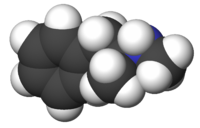This is an old revision of this page, as edited by C6541 (talk | contribs) at 14:48, 2 June 2009. The present address (URL) is a permanent link to this revision, which may differ significantly from the current revision.
Revision as of 14:48, 2 June 2009 by C6541 (talk | contribs)(diff) ← Previous revision | Latest revision (diff) | Newer revision → (diff) This article is about the psychostimulant drug, methamphetamine, in both racemic and dextrorotatory forms. For the CNS inactive OTC nasal decongestant, see levomethamphetamine.
| Editing of this article by new or unregistered users is currently disabled due to vandalism. See the protection policy and protection log for more details. If you cannot edit this article and you wish to make a change, you can submit an edit request, discuss changes on the talk page, request unprotection, log in, or create an account. |
 | |
 | |
| Clinical data | |
|---|---|
| Other names | Desoxyephedrine Pervitin Anadrex Methedrine Methylamphetamine Syndrox Desoxyn |
| Routes of administration | Medical: Oral Recreational: Oral, I.V., I.M., Insufflation, Inhalation, Suppository |
| ATC code | |
| Legal status | |
| Legal status |
|
| Pharmacokinetic data | |
| Bioavailability | 62.7% oral; 79% nasal; 90.3% smoked; 99% rectally; 100% IV |
| Metabolism | Hepatic |
| Elimination half-life | 9–15 hours |
| Excretion | Renal |
| Identifiers | |
IUPAC name
| |
| CAS Number | |
| PubChem CID | |
| ChemSpider | |
| CompTox Dashboard (EPA) | |
| ECHA InfoCard | 100.007.882 |
| Chemical and physical data | |
| Formula | C10H15N |
| Molar mass | 149.233 g/mol g·mol |
| 3D model (JSmol) | |
SMILES
| |
Methamphetamine (/mɛθæm'fɛtəmiːn/, also known as, methylamphetamine, N-methylamphetamine, and desoxyephedrine) is a psychostimulant and sympathomimetic drug.
A member of the family of phenylethylamines, methamphetamine is chiral, with two isomers:
The levorotary form, levomethamphetamine, is an over-the-counter drug used in inhalers for nasal decongestion. Levomethamphetamine does not possess any significant central nervous system activity or addictive properties. The remainder of this article deals only with the dextrorotatory form, dextromethamphetamine, or the racemic form, methamphetamine.
Methamphetamine enters the brain and triggers a cascading release of dopamine, serotonin and norepinephrine. It is highly active in the mesolimbic reward pathways of the brain, inducing intense euphoria, with risks for addiction. To a lesser extent, methamphetamine acts as a dopaminergic and adrenergic reuptake inhibitor with high concentrations serving as a monoamine oxidase inhibitor. Users may become hypersexual or obsessed with a task, thought or activity. Withdrawal is characterized by excessive sleeping, eating, and major depression, often accompanied by anxiety and drug-craving. Methamphetamine users may take sedatives such as benzodiazepines as a means of easing their "come down", anxiety or enable them to sleep.
Methamphetamine addiction typically occurs when a person begins to use it because of its powerful enhancing effects on mood and energy, weight loss and appetite suppression, among its other psychological and physical effects. Over time effectiveness decreases, and users find that they need to take higher doses to get the same results and have far greater difficulty functioning and expe
- Cite error: The named reference
ncbi.nlm.nih.govwas invoked but never defined (see the help page). - McGregor C, Srisurapanont M, Jittiwutikarn J, Laobhripatr S, Wongtan T, White J (2005). "The nature, time course and severity of methamphetamine withdrawal". Addiction. 100 (9): 1320–9. doi:10.1111/j.1360-0443.2005.01160.x. PMID 16128721.
{{cite journal}}: CS1 maint: multiple names: authors list (link) - Benzos (benzodiazepines)